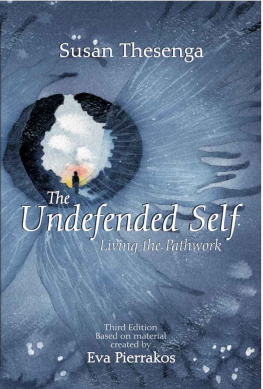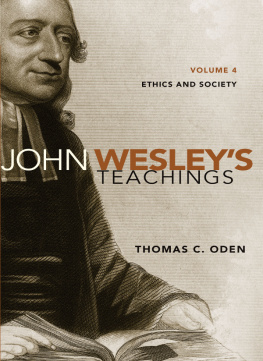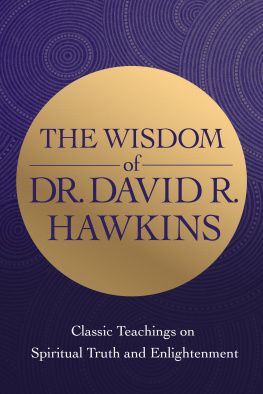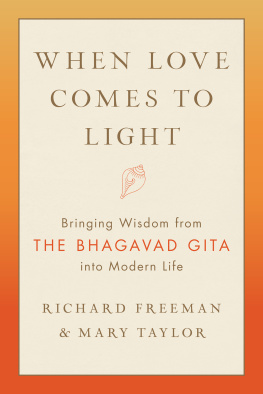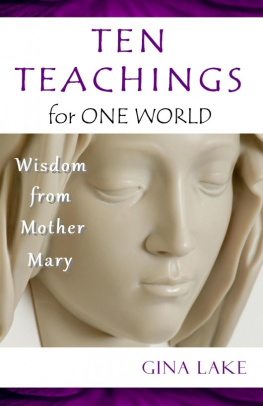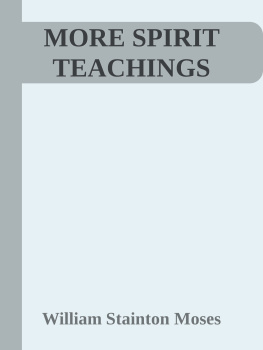Pathwork Press, P.O. Box 725, Madison, VA 22727 email: pathworkpress@pathwork.org; www.pathwork.org
Pathwork Press
P.O. Box 725
Madison, VA 22727
1993, 1994, 2001 by Susan Thesenga
All rights reserved. First edition 1993, Second edition 1994, Third edition 2001 Kindle Edition 2014
No part of this book may be reproduced or transmitted in any form or by any means, electronic or mechanical, including photocopying, recording, or by any information storage and retrieval system, without permission in writing from the publisher.
The Pathwork is a trademark owned and registered by The Pathwork Foundation, and shall not be used without the express written permission of The Pathwork Foundation.
Printed in the United States of America
11 12 13 10 9 8 7 6 5 4 3
Library of Congress Cataloging-in-Publication Data
Thesenga, Susan.
The undefended self: living the Pathwork / Susan Thesenga 3rd ed. / based on material created by Eva Pierrakos. p. cm.
Includes bibliographical references. ISBN 0-9614777-7-6 (pbk. : alk. paper)
1. Self-realizationMiscellaneous. 2. Spiritual lifeMiscellanea. I. Pierrakos, Eva, 1915-1979. II. Title.
BF637.S4 T485 2001
131dc21
2001036357
Cover Design and Art by Maggie Bice
Front cover design incorporates a drawing by Asha Greer
Drawings throughout text by Asha Greer
This book was originally part of the five-book Pathwork Series, for which
Donovan Thesenga was general editor.
Thisbookisdedicatedto
EvaBrochPierrakos,
whobroughtthePathworkwisdom toourworld.
Acknowledgmen t sandAppreciations
To the Pathwork Foundation, which gave me permissionto quote freely from the Pathwork Guide Lectures. The Pathwork Foundation holdstheexclusivecopyrighttotheselectures.
To Dr. John Pierrakos, who gave me encouragement and permission to use the text and title from Eva Pierrakoss 1965 manuscript, thentitledTheUndefendedSelf.
Tomymanysupportersalongthewaybothwithinandoutsidethe Pathworkcommunities,andespeciallytothefollowingforeditorialand technical help: Marjorie Bair, Asha Greer, Gene Humphrey, D. Patrick Miller,KarenMillnick,andJudithSaly.
T o m y mothe r an d father , wh o nurture d open-mindedness , integrity,andcourage,andtomydaughterPamela,whohastaughtme somuchaboutlovingandlettinggo.
And,mostofall,tomyhusbandandspiritualpartner,Donovan
Thesenga,whoiscentraltohowmylifeandthisbookhaveunfolded.
Content s
Chapter 1,
Chapter 2,
Chapter 3,
Chapter 4,
Chapter 5,
Chapter 6,
Chapter 7,
Chapter 8,
Chapter 9,
Chapter 10,
Chapter 11,
Eve r yhumanbeingsensesaninnerlonging thatgoesdeeperthanthelongingsfor emotionalandcreativefulfillment.
Thislongingcomesfromsensingthat anothe r , mor e ful f illin g stat e o f consciousnes s andalargercapacitytoexperiencelife
mustexist.
Pathwork Lecture 204,WhatIsThePath?
Preface
We all know intuitively that there is more to life than whatever limited reality we now experience. We long to awaken to the depths of who we are and what life could be. Whatever temporary yearnings may preoccupy usfor less pain and more joy, for a fulfilling relationship or for meaningful workthere is something that calls to us from deep within. We want to know the truth about life and we want to feel love in our hearts.
My longing to know myself and experience life more deeply was first awakened in the early 1960s through a passionate commitment to the civil rights movement. In my calling to join this great struggle for liberation, I was also pursuing my own freedom. I longed to expand my knowing of self and life beyond the limitations of the safe, comfortable cotton batting of my suburban, white, middle-class 1940s and 1950s upbringing, which had denied and muffled all extremes of the human experience. I wanted to go deeper, to know real life, and to confront the evil of racism. I was opening to the deep pain of our countrys racial history, testing the limits of my courage, and sensing the union beneath apparent opposites. I longed to know the one heart that beats in us all, whether black or white, rich or poor.
But, while my work in civil rights made me feel truly engaged in life, it also left me angry and unhappy, as I made my own liberation dependent on societys achievement of racial justice. My inner division and distress eventually prompted me to seek therapy and to begin the journey of looking inside rather than outside for the source of meaning and fulfillment in my life.
My intensive self-search eventually led me into alternative therapies and group experiencesGestalt, bioenergetics, Tavistock group process, humanistic psychology. My first encounter group in 1967 was an experience of coming home. I was given permission to speak what Id always felt: that underneath our civilized politeness and masks of niceness and competence, people are full of wild and woolly feelingsrage and fear, and mountains of pain. And that these unrecognized inner states cause us to do and say all sorts of things we later regret and that keep us from the happiness we say we want. The inner world of feelings had always been more palpable for me than outer rules and roles; I just hadnt known how to name what was real. As I gobbled up more therapy and group experiences, letting out my own fear, pain, and rage, I felt my heart was opening and a deep, empty well of emotional deprivation was, at last, being filled.
I had ecstatic moments of touching into the one heart of love beyond all our individuality. I felt certain that a powerful spiritual influx was penetrating the planet and would soon transform our collective consciousness of egotistic separation, which created so much pain and injustice. By 1969, when I arrived at the Esalen Institute in Big Sur, California, I knew that a deeper, unnamable part of me was in charge. I had a vision of being tied to one end of a rope, the other end of which was wrapped around a giant winch pulling me, inexorably, home back to a source or center I could not name but knew was real, more real than anything in my outer world.

